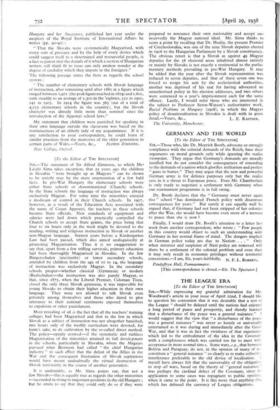[To the Editor of THE SPECTATOR] SIR, — The statement of Sir
Alfred Zimmern, to which Mr• Laszlo Sima takes exception, that 25 years ago the children in Slovakia "were brought up as Magyars" can bc shown to be strictly true by the mere enumeration of a few bald facts. In pre-War Hungary the elementary schools were either State schools or denominational (Church) schools. In the State schools the language of instruction was always exclusively Magyar. For some time the minorities enjoyed a modicum of control in their Church schools. In 1907, however, as a result of the Education Acts associated with the name of Count Apponyi, the teachers in these schools became State officials. New standards of equipment and salaries were laid down which practically compelled the Church schools to accept State grants, the price being that four to six hours only in the week might be devoted to the reading, writing and religious instruction in Slovak or another non-Magyar language. Sixteen years before a Kindergarten Law had been passed, which also aimed undisguisedly at promoting Magyarisation. Thus it is no exaggeration to say that, apart from a few trifling survivals, primary education had been thoroughly Magyarised in Slovakia. In the few Biirgerschulen (mekianky) or lower secondary schools, attended by children from the age of zo to 14, the language of instruction was exclusively Magyar. In the secondary schools proper—whether classical (Gymnasia) or modern (Realschulen)—the instruction was also purely Magyar, so that, since 1875, when the Liberal Premier, Coloman Tisza, closed the only three Slovak gymnasia, it was impossible for young Slovaks to obtain their higher education in their own language. They were not allowed to talk Slovak even privately among themselves and those who dared to give utterance to their national sentiments exposed themselves to expulsion or other punishment.
Most revealing of all is the fact that all the teachers' training colleges had been Magyarised and that in the few in which Slovak as a subject of instruction was not altogether banished, two hours only of the weekly curriculum were devoted, for form's sake, to its cultivation by the so-called direct method. The policy—openly avowed—of the systematic and ruthless Magyarisation of the minorities attained its full develepment in the schools, particularly in Slovakia, where the Magyars pursued what Bjornson had called "the chief Hungarian industry" to such effect that the defeat of the Allies in the War and the consequent frustration of Slovak aspirations would have meant undoubtedly the virtual destruction of Slovak nationality in the course of another generation.
It is undeniable, as Mr. Sima points out, that not a few Slovaks—this is equally true as regards the other minorities —succeeded in rising to important positions in the old Hungary ; but he omits to say that they could only do so if they were
prepared to renounce their own nationality and accept un- reservedly the Magyar national ideal. Mr. Sima thinks to score a point by recalling that Dr. Hodia, the present Premier of Czechoslovakia, was one of the nine Slovak deputies elected in 1906 to the Hungarian Parliament by a Slovak constituency. The obvious retort is that 9 Slovak as against 49 Magyar deputies for the 58 electoral areas inhabited almost entirely or mainly by Slovaks is not exactly a testimonial to the parlia- mentary methods prevailing in pre-War Hungary. It may be added that the year after the Slovak representation was reduced to seven deputies, and that of these seven one was forced to resign his seat by the ecclesiastical authorities, another was deprived of his seat for having advocated an unauthorised policy in his election addresses, and two others were sentenced to a year's imprisonment each for the same offence. Lastly, I would refer those who are interested in the subject to Professor Seton-Watson's authoritative work, Racial Problems in Hungary (1908), in which the Magyar policy of denationalisation in Slovakia is dealt with in great


























































 Previous page
Previous page